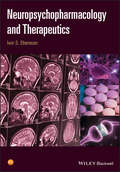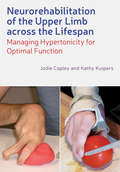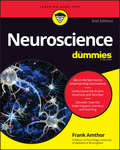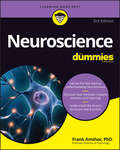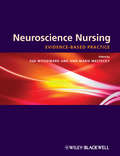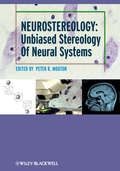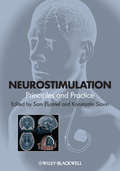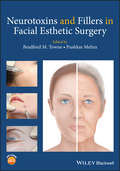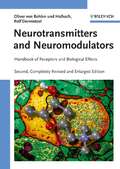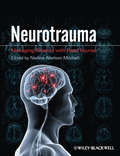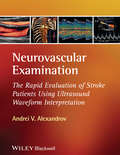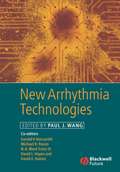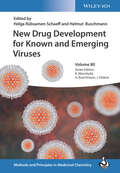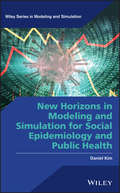- Table View
- List View
Neuropsychopharmacology and Therapeutics
by Ivor EbenezerNeuropsychopharmacology is a relatively new subject area in the neurosciences. It is a field of study that describes the effects of drugs from the molecular to the behavioural level and requires integration and synthesis of knowledge from various disciplines including neuroanatomy, physiology, molecular biology, pharmacology and the behavioural sciences. The principal aims of this book are to provide students with a clear understanding of CNS disorders, and an appreciation of how basic and clinical research findings can be translated into therapeutics. After an introduction to the subject area, the remaining chapters are focused on reviewing the main psychiatric and neurological disorders that are covered in most courses. They are discussed in terms of their clinical symptoms, epidemiology, pathology, aetiology, underlying neurobiological and neurochemical mechanisms, pharmacotherapy, adjunctive non-pharmacological treatments, and clinical outcomes. Each chapter of the book is a ‘stand-alone’ chapter and is written in a clear, accessible style. Written by an author with many years teaching and research experience, this textbook will prove invaluable for students of pharmacology, pharmacy and the medical sciences needing a truly integrated introduction to this exciting field.
Neuropsychopharmacology and Therapeutics
by Ivor EbenezerNeuropsychopharmacology is a relatively new subject area in the neurosciences. It is a field of study that describes the effects of drugs from the molecular to the behavioural level and requires integration and synthesis of knowledge from various disciplines including neuroanatomy, physiology, molecular biology, pharmacology and the behavioural sciences. The principal aims of this book are to provide students with a clear understanding of CNS disorders, and an appreciation of how basic and clinical research findings can be translated into therapeutics. After an introduction to the subject area, the remaining chapters are focused on reviewing the main psychiatric and neurological disorders that are covered in most courses. They are discussed in terms of their clinical symptoms, epidemiology, pathology, aetiology, underlying neurobiological and neurochemical mechanisms, pharmacotherapy, adjunctive non-pharmacological treatments, and clinical outcomes. Each chapter of the book is a ‘stand-alone’ chapter and is written in a clear, accessible style. Written by an author with many years teaching and research experience, this textbook will prove invaluable for students of pharmacology, pharmacy and the medical sciences needing a truly integrated introduction to this exciting field.
Neurorehabilitation of the Upper Limb Across the Lifespan: Managing Hypertonicity for Optimal Function
by Jodie Copley Kathy KuipersA comprehensive guide to managing spastic hypertonia after brain injury and the first full overview of this area The ideal reference for therapeutic interventions that optimise arm and hand function to support goal achievement An extensive clinical manual for neurological practice, a key reference for students and qualified practitioners, and a valuable resource for all occupational therapists and physiotherapists working with brain-injured clients
Neurorehabilitation of the Upper Limb Across the Lifespan: Managing Hypertonicity for Optimal Function
by Jodie Copley Kathy KuipersA comprehensive guide to managing spastic hypertonia after brain injury and the first full overview of this area The ideal reference for therapeutic interventions that optimise arm and hand function to support goal achievement An extensive clinical manual for neurological practice, a key reference for students and qualified practitioners, and a valuable resource for all occupational therapists and physiotherapists working with brain-injured clients
Neuroscience For Dummies: 2nd Edition
by Frank AmthorGet on the fast track to understanding neuroscience Investigating how your senses work, how you move, and how you think and feel, Neuroscience For Dummies, 2nd Edition is your straight-forward guide to the most complicated structure known in the universe: the brain. Covering the most recent scientific discoveries and complemented with helpful diagrams and engaging anecdotes that help bring the information to life, this updated edition offers a compelling and plain-English look at how the brain and nervous system function. Simply put, the human brain is an endlessly fascinating subject: it holds the secrets to your personality, use of language, memories, and the way your body operates. In just the past few years alone, exciting new technologies and an explosion of knowledge have transformed the field of neuroscience—and this friendly guide is here to serve as your roadmap to the latest findings and research. Packed with new content on genetics and epigenetics and increased coverage of hippocampus and depression, this new edition of Neuroscience For Dummies is an eye-opening and fascinating read for readers of all walks of life. Covers how gender affects brain function Illustrates why some people are more sensitive to pain than others Explains what constitutes intelligence and its different levels Offers guidance on improving your learning What is the biological basis of consciousness? How are mental illnesses related to changes in brain function? Find the answers to these and countless other questions in Neuroscience For Dummies, 2nd Edition
Neuroscience For Dummies
by Frank AmthorGet on the fast track to understanding neuroscience Investigating how your senses work, how you move, and how you think and feel, Neuroscience For Dummies, 2nd Edition is your straight-forward guide to the most complicated structure known in the universe: the brain. Covering the most recent scientific discoveries and complemented with helpful diagrams and engaging anecdotes that help bring the information to life, this updated edition offers a compelling and plain-English look at how the brain and nervous system function. Simply put, the human brain is an endlessly fascinating subject: it holds the secrets to your personality, use of language, memories, and the way your body operates. In just the past few years alone, exciting new technologies and an explosion of knowledge have transformed the field of neuroscience—and this friendly guide is here to serve as your roadmap to the latest findings and research. Packed with new content on genetics and epigenetics and increased coverage of hippocampus and depression, this new edition of Neuroscience For Dummies is an eye-opening and fascinating read for readers of all walks of life. Covers how gender affects brain function Illustrates why some people are more sensitive to pain than others Explains what constitutes intelligence and its different levels Offers guidance on improving your learning What is the biological basis of consciousness? How are mental illnesses related to changes in brain function? Find the answers to these and countless other questions in Neuroscience For Dummies, 2nd Edition
Neuroscience For Dummies
by Frank AmthorA fascinating look at what’s rattling around in your skull Neuroscience For Dummies introduces you to the mind-boggling study of the human brain. It tracks to the content of a typical introductory neuroscience class at the college level —and it’s perfect for anyone curious about what makes us tick. New technologies and an explosion of research have completely transformed our understanding of memory, depression, the mind-body connection, learning, and genetics. This updated edition—still in classic, beginner-friendly Dummies style—covers the latest research advances and technologies in the field of neuroscience. Put some knowledge about the brain into your brain. Grasp the basic concepts and applications of neuroscience Understand the brain’s structure and function Explore how the brain impacts memory, learning, and emotions Discover how the brain is connected with other physical systemsFor students and general readers alike, Neuroscience For Dummies is a great way to understand what’s going on inside our heads.
Neuroscience For Dummies
by Frank AmthorA fascinating look at what’s rattling around in your skull Neuroscience For Dummies introduces you to the mind-boggling study of the human brain. It tracks to the content of a typical introductory neuroscience class at the college level —and it’s perfect for anyone curious about what makes us tick. New technologies and an explosion of research have completely transformed our understanding of memory, depression, the mind-body connection, learning, and genetics. This updated edition—still in classic, beginner-friendly Dummies style—covers the latest research advances and technologies in the field of neuroscience. Put some knowledge about the brain into your brain. Grasp the basic concepts and applications of neuroscience Understand the brain’s structure and function Explore how the brain impacts memory, learning, and emotions Discover how the brain is connected with other physical systemsFor students and general readers alike, Neuroscience For Dummies is a great way to understand what’s going on inside our heads.
Neuroscience Nursing: Evidence-Based Theory and Practice (Oxford Handbooks In Nursing Ser.)
by Sue Woodward Ann-Marie Mestecky“Superior… An important resource for nurses” Shanne McNamara, Vice President, British Association of Neuroscience Nurses Neuroscience Nursing is a comprehensive, practical text that reflects both the richness and the diversity of contemporary neuroscience nursing. It aims to inform the practice of neuroscience nursing through the report of current research, best available evidence, policy and education. This important new book is divided into several sections exploring anatomy and physiology of the nervous system; assessment, interpretation and management of specific problems in the neurological patient; neurological investigations and neurosurgical procedures; management of patients with intracranial disorders; and management of patients with long-term conditions. It also explores the underpinning concepts of neuroscience care, including its history and development, and legal and ethical issues. Uniquely, this text also includes patients’ perspectives of living with a variety of neurological conditions. Key features: The first evidence-based UK neuroscience textbook for nurses Extensive full colour illustrations throughout Applicable to a wide variety of settings including prevention, primary care, acute and critical care, rehabilitation and palliative care Contributions from nurse specialists, nurse consultants, academics and subject experts from throughout the UK
Neuroscience Nursing: Evidence-Based Theory and Practice
by Sue Woodward Ann-Marie Mestecky“Superior… An important resource for nurses” Shanne McNamara, Vice President, British Association of Neuroscience Nurses Neuroscience Nursing is a comprehensive, practical text that reflects both the richness and the diversity of contemporary neuroscience nursing. It aims to inform the practice of neuroscience nursing through the report of current research, best available evidence, policy and education. This important new book is divided into several sections exploring anatomy and physiology of the nervous system; assessment, interpretation and management of specific problems in the neurological patient; neurological investigations and neurosurgical procedures; management of patients with intracranial disorders; and management of patients with long-term conditions. It also explores the underpinning concepts of neuroscience care, including its history and development, and legal and ethical issues. Uniquely, this text also includes patients’ perspectives of living with a variety of neurological conditions. Key features: The first evidence-based UK neuroscience textbook for nurses Extensive full colour illustrations throughout Applicable to a wide variety of settings including prevention, primary care, acute and critical care, rehabilitation and palliative care Contributions from nurse specialists, nurse consultants, academics and subject experts from throughout the UK
Neurostereology: Unbiased Stereology of Neural Systems
by P. R. MoutonStereological methods provide researchers with unparalleled quantitative data from tissue samples and allow for well-evidenced research advances in a broad range of scientific fields. Presenting a concise introduction to the methodology and application of stereological research in neuroscience, Neurostereology provides a fuller understanding of the use of these methods in research and a means for replicating successful scientific approaches. Providing sound footing for future research, Neurostereology is a useful tool for basic and clinical researchers and advanced students looking to integrate these methods into their research.
Neurostereology: Unbiased Stereology of Neural Systems
by P. R. MoutonStereological methods provide researchers with unparalleled quantitative data from tissue samples and allow for well-evidenced research advances in a broad range of scientific fields. Presenting a concise introduction to the methodology and application of stereological research in neuroscience, Neurostereology provides a fuller understanding of the use of these methods in research and a means for replicating successful scientific approaches. Providing sound footing for future research, Neurostereology is a useful tool for basic and clinical researchers and advanced students looking to integrate these methods into their research.
Neurostimulation: Principles and Practice
by Sam Eljamel Konstantin V. SlavinCould neurostimulation be a management option for your patients? Neurostimulation techniques present real management options for patients with a range of neurologic and psychiatric disorders, such as movement disorders, pain, and depression. They should be actively considered when conventional medical approaches have failed or are inappropriate. But for many clinicians, these new methods pose many questions. What are the available modalities? How do they work? Which patients might benefit from them? How do I explain the processes to patients? How do I monitor my patient’s progress after implantation? Neurostimulation: Principles and Practice provides a concise, easy-to-read fusion of the clinical applications of implanted neurostimulators. It demystifies selection and referral criteria, maximizing therapy, programming the implanted neuromodulators, monitoring progress, and troubleshooting problems associated with neurostimulation. Neurostimulation: Principles and Practice covers the modalities available for your patients: Deep brain stimulation Motor cortex stimulation Vagus nerve stimulation Spinal cord stimulation Peripheral nerve stimulation Written by an international cast of experts, Neurostimulation: Principles and Practice sets the stage for you to provide real clinical benefit to your patients who might receive, or are already using, neurostimulators.
Neurostimulation: Principles and Practice
by Sam Eljamel Konstantin SlavinCould neurostimulation be a management option for your patients? Neurostimulation techniques present real management options for patients with a range of neurologic and psychiatric disorders, such as movement disorders, pain, and depression. They should be actively considered when conventional medical approaches have failed or are inappropriate. But for many clinicians, these new methods pose many questions. What are the available modalities? How do they work? Which patients might benefit from them? How do I explain the processes to patients? How do I monitor my patient’s progress after implantation? Neurostimulation: Principles and Practice provides a concise, easy-to-read fusion of the clinical applications of implanted neurostimulators. It demystifies selection and referral criteria, maximizing therapy, programming the implanted neuromodulators, monitoring progress, and troubleshooting problems associated with neurostimulation. Neurostimulation: Principles and Practice covers the modalities available for your patients: Deep brain stimulation Motor cortex stimulation Vagus nerve stimulation Spinal cord stimulation Peripheral nerve stimulation Written by an international cast of experts, Neurostimulation: Principles and Practice sets the stage for you to provide real clinical benefit to your patients who might receive, or are already using, neurostimulators.
Neurotoxins and Fillers in Facial Esthetic Surgery
by Bradford M. Towne Pushkar MehraThis book offers a detailed, practical guide to incorporating minimally invasive cosmetic surgery into dental practice. Chapters thoroughly examine all aspects of using these materials in practice, and present step-by-step techniques for injecting and placing neurotoxins and fillers, with specific recommendations for product selection and in-depth information on case management. Anatomical drawings and clinical photographs depict the procedures and concepts described. From patient evaluation, treatment planning, and product selection to techniques, managing complications, and marketing the service, Neurotoxins and Fillers in Facial Esthetic Surgery provides a complete resource for using these techniques in practice. Coverage encompasses facial anatomy, neurotoxins, cosmetic fillers, hyaluronic acid dermal fillers, Radiesse™ calcium hydroxylapatite injectable filler, pearls and pitfalls, and how to build your practice. Offers a complete but easy-to-use-reference on all aspects of how to set up a minimally invasive cosmetic facial surgery service within an oral and maxillofacial surgery practice Surveys the range of products available in detail from an objective viewpoint Presents how-to techniques for injecting and placing neurotoxins and fillers Neurotoxins and Fillers in Facial Esthetic Surgery is an essential reference for any oral and maxillofacial surgeon or general dentist wishing to add minimally invasive cosmetic surgery to their repertoire.
Neurotoxins and Fillers in Facial Esthetic Surgery
by Bradford M. Towne Pushkar MehraThis book offers a detailed, practical guide to incorporating minimally invasive cosmetic surgery into dental practice. Chapters thoroughly examine all aspects of using these materials in practice, and present step-by-step techniques for injecting and placing neurotoxins and fillers, with specific recommendations for product selection and in-depth information on case management. Anatomical drawings and clinical photographs depict the procedures and concepts described. From patient evaluation, treatment planning, and product selection to techniques, managing complications, and marketing the service, Neurotoxins and Fillers in Facial Esthetic Surgery provides a complete resource for using these techniques in practice. Coverage encompasses facial anatomy, neurotoxins, cosmetic fillers, hyaluronic acid dermal fillers, Radiesse™ calcium hydroxylapatite injectable filler, pearls and pitfalls, and how to build your practice. Offers a complete but easy-to-use-reference on all aspects of how to set up a minimally invasive cosmetic facial surgery service within an oral and maxillofacial surgery practice Surveys the range of products available in detail from an objective viewpoint Presents how-to techniques for injecting and placing neurotoxins and fillers Neurotoxins and Fillers in Facial Esthetic Surgery is an essential reference for any oral and maxillofacial surgeon or general dentist wishing to add minimally invasive cosmetic surgery to their repertoire.
Neurotransmitters and Neuromodulators: Handbook of Receptors and Biological Effects
by Oliver von Bohlen und Halbach Rolf DermietzelA complete update of the highly acclaimed handbook with data on all neurotransmitters and the majority of neuromodulators. The coverage is now even more comprehensive, with 15% more entries on neuropeptides, "classic" neurotransmitters and related substances in a clear, alphabetical format. The methodological section has been expanded by 50% and now includes color figures, plus new chapters on genomics, proteomics, databases, microarrays, MALDI-TOF, neutrophins, FGF, endocannabinoids and neuroimaging. The text provides clearly structured information on the biosynthesis and degradation, localization, receptors, signal transduction pathways, and biological effects in the central nervous system, with all substances uniformly treated for an easy comparison of data. Furthermore, introductory chapters on receptors, transporters, and the blood-brain barrier make this an indispensable tool for researchers, teachers, and advanced students, as well as a must-have for every neuroscientist.
Neurotrauma: Managing Patients with Head Injury
by Nadine Abelson-MitchellNeurotrauma: Managing Patients with Head Injuries is a comprehensive, holistic, evidence-based approach to the primary, secondary and tertiary care of a person with neurotrauma. Using a patient-centred needs approach to enhance the quality of care of head injured patients, family and carers, this multidisciplinary book enables the reader to apply the knowledge, skills and attitudes learned to the practice of neurotrauma in all settings. It explores: Anatomy and physiology of the brain Pharmacology for neurotrauma patients Assessment of the patient with neurotrauma Management of neurotrauma in a range of settings including at the scene, in the emergency department, and at the hospital Neuro-rehabilitation Community care Nursing management of the patient This practical resource includes activities, exercises, and ethical and legal considerations throughout, making it ideal reading for all staff working in neuroscience, emergency, critical and rehabilitation settings.
Neurotrauma: Managing Patients with Head Injury
by Nadine Abelson-MitchellNeurotrauma: Managing Patients with Head Injuries is a comprehensive, holistic, evidence-based approach to the primary, secondary and tertiary care of a person with neurotrauma. Using a patient-centred needs approach to enhance the quality of care of head injured patients, family and carers, this multidisciplinary book enables the reader to apply the knowledge, skills and attitudes learned to the practice of neurotrauma in all settings. It explores: Anatomy and physiology of the brain Pharmacology for neurotrauma patients Assessment of the patient with neurotrauma Management of neurotrauma in a range of settings including at the scene, in the emergency department, and at the hospital Neuro-rehabilitation Community care Nursing management of the patient This practical resource includes activities, exercises, and ethical and legal considerations throughout, making it ideal reading for all staff working in neuroscience, emergency, critical and rehabilitation settings.
Neurovascular Examination: The Rapid Evaluation of Stroke Patients Using Ultrasound Waveform Interpretation
by Andrei V. AlexandrovThe use of neurovascular ultrasound is of increasing importance in neurological practice, both for radiologists and increasingly by neurologists themselves. Written by the world’s most renowned expert, this book explains ultrasound examination of a stroke patient scanning protocols interpretation of the results Case examples (with a standard template presentation correlating presentation to waveform output) reinforce the book's practical nature. Illustrated with photos of the tests, explanations, and with actual waveforms, images, and result interpretation, and enhanced with 'pearls' and 'avoiding pitfalls' features, it is a practical reference for those learning ultrasound as well as those using ultrasound in their practices.
Neurovascular Examination: The Rapid Evaluation of Stroke Patients Using Ultrasound Waveform Interpretation
by Andrei V. AlexandrovThe use of neurovascular ultrasound is of increasing importance in neurological practice, both for radiologists and increasingly by neurologists themselves. Written by the world’s most renowned expert, this book explains ultrasound examination of a stroke patient scanning protocols interpretation of the results Case examples (with a standard template presentation correlating presentation to waveform output) reinforce the book's practical nature. Illustrated with photos of the tests, explanations, and with actual waveforms, images, and result interpretation, and enhanced with 'pearls' and 'avoiding pitfalls' features, it is a practical reference for those learning ultrasound as well as those using ultrasound in their practices.
New Arrhythmia Technologies
by Paul J. Wang Gerald V. Naccarelli Michael R. Rosen N. A. Mark Estes David L. Hayes David E. HainesNew Arrhythmia Technologies provides a complete discussion of recent, emerging, and future arrhythmia technologies. This forward-thinking book details successful trials and investigates areas of research that have not yet reached the trial phase. The elite panel of authors have explored fresh information on: advances in antiarrhythmic pharmacologis therapy advances in monitoring, risk assessment, and noninvasive mapping advances in pacing therapy advances in implantable defibrillators advances in catheter and surgical ablation advances in antiarrhythmic biological therapy vision for the future of arrhythmia technologies web-based defibrillation monitoring. New Arrhythmia Technologies presents a unique view of the latest in arrhythmia innovations through the eyes of the experts in the field.
New Drug Development for Known and Emerging Viruses (Methods & Principles in Medicinal Chemistry)
by Raimund Mannhold Jörg HolenzDiscusses how to fight Ebola, SARS Corona, and other known or emerging human viruses by building on the successes in antiviral therapy of the past decades Written by leading medicinal chemists from academia and industry, this book discusses the entire field of antiviral drug discovery and development from a medicinal chemistry perspective, focusing on antiviral drugs, targets, and viral disease mechanisms. It provides an outlook on emerging pathogens such as Ebola, Zika, West Nile, Lassa, and includes a chapter on SARS Coronoavirus-2 causing the present pandemic. New Drug Development for Known and Emerging Viruses describes the discovery and development process for antiviral agents for different classes of viruses and targets based on the experiences from the nine human viruses for which approved drugs are on the market (HIV, HCV, Influenza, RSV, HBV, HPV, HCMV, HSV, and VZV). It covers the properties and potential of 20 classes of currently approved antivirals, including combination drugs, and looks at novel antiviral strategies against emerging viruses. Covers the entire field of antiviral drug discovery and development Addresses the need for antiviral drugs to combat major health threats such as Ebola, Zika, West Nile, and SARS Coronavirus-2 Summarizes the successes of the past 15 years in developing ground-breaking medicines against 9 major human viruses, both from the medicinal chemistry and the pharmacological angle Discusses practical and strategic challenges in the drug discovery and development process, including screening technologies, latency, and toxicity issues New Developments in Antiviral Drugs is an important book for medicinal chemists, pharmaceutical chemists, virologists, and epidemiologists, and will be of great interest to those in the pharmaceutical industry and public health agencies.
New Drug Development for Known and Emerging Viruses (Methods & Principles in Medicinal Chemistry)
by Raimund Mannhold Jörg HolenzDiscusses how to fight Ebola, SARS Corona, and other known or emerging human viruses by building on the successes in antiviral therapy of the past decades Written by leading medicinal chemists from academia and industry, this book discusses the entire field of antiviral drug discovery and development from a medicinal chemistry perspective, focusing on antiviral drugs, targets, and viral disease mechanisms. It provides an outlook on emerging pathogens such as Ebola, Zika, West Nile, Lassa, and includes a chapter on SARS Coronoavirus-2 causing the present pandemic. New Drug Development for Known and Emerging Viruses describes the discovery and development process for antiviral agents for different classes of viruses and targets based on the experiences from the nine human viruses for which approved drugs are on the market (HIV, HCV, Influenza, RSV, HBV, HPV, HCMV, HSV, and VZV). It covers the properties and potential of 20 classes of currently approved antivirals, including combination drugs, and looks at novel antiviral strategies against emerging viruses. Covers the entire field of antiviral drug discovery and development Addresses the need for antiviral drugs to combat major health threats such as Ebola, Zika, West Nile, and SARS Coronavirus-2 Summarizes the successes of the past 15 years in developing ground-breaking medicines against 9 major human viruses, both from the medicinal chemistry and the pharmacological angle Discusses practical and strategic challenges in the drug discovery and development process, including screening technologies, latency, and toxicity issues New Developments in Antiviral Drugs is an important book for medicinal chemists, pharmaceutical chemists, virologists, and epidemiologists, and will be of great interest to those in the pharmaceutical industry and public health agencies.
New Horizons in Modeling and Simulation for Social Epidemiology and Public Health (Wiley Series in Modeling and Simulation)
by Daniel KimAn introduction to state-of-the-art modeling and simulation approaches for social and economic determinants of population health New Horizons in Modeling and Simulation for Social Epidemiology and Public Health offers a comprehensive introduction to modeling and simulation that addresses the many complex research questions in social epidemiology and public health. This book highlights a variety of practical applications and illustrative examples with a focus on modeling and simulation approaches for the social and economic determinants of population health. The book contains classic case examples in agent-based modeling (ABM) as well as essential information on ABM applications to public health including for infectious disease modeling, obesity, and tobacco control. This book also surveys applications of microsimulation (MSM) including of tax-benefit policies to project impacts of the social determinants of health. Specifically, this book: Provides an overview of the social determinants of health and the public health significance of addressing the social determinants of health Gives a conceptual foundation for the application of ABM and MSM to study the social determinants of health Offers methodological introductions to both ABM and MSM approaches with illustrative examples Includes cutting-edge systematic reviews of empirical applications of ABM and MSM in the social sciences, social epidemiology, and public health Discusses future directions for empirical research using ABM and MSM, including integrating aspects of both ABM and MSM and implications for public health policies Written for a broad audience of policy analysts, public planners, and researchers and practitioners in public health and public policy including social epidemiologists, New Horizons in Modeling and Simulation for Social Epidemiology and Public Health offers a fundamental guide to the social determinants of health and state-of-the-art applications of ABM and MSM to studying the social and economic determinants of population health.
